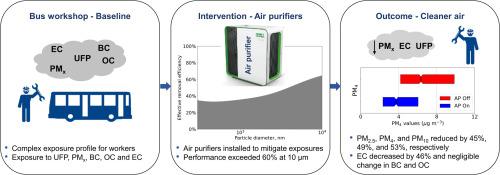Impact of air purifiers on occupational particle exposure in an enclosed bus workshop
IF 7.6
1区 工程技术
Q1 CONSTRUCTION & BUILDING TECHNOLOGY
引用次数: 0
Abstract
Workers in bus workshops are exposed to elevated concentrations of fine (PM2.5, <2.5 µm) and ultrafine particles (UFP, <0.1 µm) from diesel exhaust, brake and tire wear, and mechanical operations, which are associated with adverse respiratory and cardiovascular outcomes. To characterize exposures and evaluate mitigation strategies, two measurement campaigns were conducted in a bus workshop. Particle number concentrations (PNC), size distributions, black carbon (BC), elemental and organic carbon (EC/OC), and particulate mass (PM2.5, PM4, PM10) were monitored at near field, breathing zones, and far field locations during maintenance tasks. The first campaign established baseline conditions, while the second assessed the impact of four air purifiers (APs). Baseline monitoring showed exposure peaks during high-emission activities such as brake servicing, and cold engine starts, with PNCs reaching 4.5 × 105 cm-3 and PM4 up to 549 µg m-3. While gravimetric concentrations remained below mass-based occupational exposure limits, UFPs and EC exceeded precautionary health benchmarks. The use of APs increased the effective air exchange rate and reduced PNCs (<700 nm) by 38%, and PM2.5, PM4, and PM10 by 45%, 49%, and 53%, respectively. EC decreased by 46%, whereas BC and OC showed negligible changes. Size-resolved analysis confirmed highest removal efficiency for coarse particles (60% at 10 µm) and lowest (33%) within 300-700 nm range, the most penetrating particle size. This study demonstrates that bus workshops present clear risks of occupational particle exposure, and that APs can significantly reduce concentrations, though limitations remain for UFPs and semi-volatile organics.

密闭客车车间空气净化器对职业性颗粒物暴露的影响
公共汽车车间的工人暴露在柴油废气、刹车和轮胎磨损以及机械操作产生的高浓度细颗粒物(PM2.5, 2.5 μ m)和超细颗粒物(UFP, 0.1 μ m)中,这与不良的呼吸和心血管疾病有关。为了描述暴露特征和评估缓解战略,在一个公共汽车车间开展了两次测量活动。在维护任务期间,在近场、呼吸区和远场位置监测颗粒数浓度(PNC)、粒径分布、黑碳(BC)、元素碳和有机碳(EC/OC)和颗粒质量(PM2.5、PM4、PM10)。第一项运动建立了基线条件,而第二项运动评估了四种空气净化器(ap)的影响。基线监测显示,在刹车维修和发动机冷启动等高排放活动期间,pmnc达到4.5 × 105 cm-3, PM4高达549µg -3。虽然重量浓度仍低于基于质量的职业接触限值,但ufp和EC超过了预防性健康基准。ap的使用提高了有效空气交换率,使pnc (700 nm)降低38%,PM2.5、PM4和PM10分别降低45%、49%和53%。EC下降46%,而BC和OC的变化可以忽略不计。尺寸分辨分析证实,在10µm范围内,粗颗粒的去除效率最高(60%),在300-700 nm范围内,穿透性最强的颗粒尺寸,去除效率最低(33%)。这项研究表明,公共汽车车间存在明显的职业性颗粒暴露风险,尽管对ufp和半挥发性有机物的限制仍然存在,但ap可以显著降低浓度。
本文章由计算机程序翻译,如有差异,请以英文原文为准。
求助全文
约1分钟内获得全文
求助全文
来源期刊

Building and Environment
工程技术-工程:环境
CiteScore
12.50
自引率
23.00%
发文量
1130
审稿时长
27 days
期刊介绍:
Building and Environment, an international journal, is dedicated to publishing original research papers, comprehensive review articles, editorials, and short communications in the fields of building science, urban physics, and human interaction with the indoor and outdoor built environment. The journal emphasizes innovative technologies and knowledge verified through measurement and analysis. It covers environmental performance across various spatial scales, from cities and communities to buildings and systems, fostering collaborative, multi-disciplinary research with broader significance.
 求助内容:
求助内容: 应助结果提醒方式:
应助结果提醒方式:


